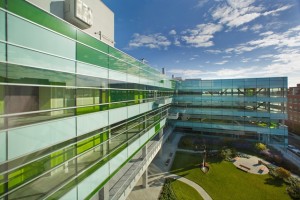Picture an industrial-sized manufacturing plant in which workers are turning out a valuable chemical product, say a pharmaceutical drug, or an exotic material such as a truly biodegradable plastic, or a clean-burning carbon-neutral transportation fuel. Now picture that plant as being void of smokestacks venting carbon dioxide into the atmosphere, or receptacles for the collecting of toxic, non-recyclable waste. This is the promise of biomanufacturing, in which biological organisms or systems are used to make desired molecules, and it has the potential to become one of the defining technologies of the 21st century.
A Berkeley Lab proposal submitted to the Defense Advanced Research Projects Agency (DARPA) for the establishment of a scientific center for biomanufacturing has passed a crucial first test. DARPA has awarded the Lab $1.5 million to proceed with a “Task Area 1” (TA1) design and study phase for what is being called “BOB” – for Berkeley Open Biofoundry. By providing the science and technology that will enable the engineering of biological systems to produce valuable chemical products on a commercial scale, BOB is conceived to do for biology what the Molecular Foundry does for nanomaterials.
“The idea behind BOB is to create a new type of user facility in which industrial, academic, and government stakeholders will have access to engineered biological systems, including microbes, plants and tissues, at all stages of the engineering process, including design, building, testing and learning,” says Mary Maxon, the head of strategic planning and development for Biosciences at Berkeley Lab who is spearheading this proposal along with Jay Keasling, Berkeley Lab’s Associate Lab Director for Biosciences. “BOB represents an important step along a pathway that will ultimately lead to a biomanufacturing center for excellence. This center of excellence is envisioned to be a Silicon Valley-style ecosystem of engineering for biology where designs and start-up systems are created but manufacturing is done elsewhere.”
Manufacturing is defined as the human transformation of materials from one form to another, more valuable form. Whereas many traditional manufacturing processes deplete natural resources and damage the environment, biomanufacturing can be both sustainable and environmentally benign. The primary challenges to biomanufacturing have been complexity and cost. Despite these challenges, biomanufacturing now accounts for more than $190 billion annually in U.S. revenues, with California, the birthplace of genetic engineering, accounting for roughly 22-percent of that figure.
“Biomanufacturing could be a significantly larger fraction of the U.S. economy if biology were easier and cheaper to engineer,” says Keasling, who provided a look into what biomanufacturing can offer with the engineering of a strain of yeast that can be used to produce artemisinin, the world’s most powerful anti-malaria drug. When exclusively produced from the wormwood plant, the supply of artemisinin was unreliable and its price too high for the people in developing nations who need it most. With the arrival of a microbial-based form of the drug, the supply has stabilized and the price has become affordable.
“The construction of the artemisinin-producing yeast required $25 million in funding and 150 person-years of work, typical of similar-sized bioengineering projects,” Keasling says. “New synthetic biology and computational technologies are needed to accelerate the development of productive biological systems and reduce their costs, and industry needs access to them if traditional manufacturing is to be transformed by biomanufacturing.”
“Within the first five years of BOB, if it is fully funded by DARPA and corporate users, we will aim to speed the design time for developing desired biological systems so that it will be 50 times faster than it is today,” Maxon says. “We’ll also aim to make construction time five times faster than it is now and reduce costs by a factor of 20. The goal is to generate 350 molecules that currently can’t be manufactured with biological methods, including some that currently rely on petroleum sources and traditional manufacturing.”

BOB, the Berkeley Open Biofoundry, would be housed in the EmeryStation East building in Emeryville along with DOE’s Joint BioEnergy Institute (JBEI). (Photo by Roy Kaltschmidt)
The proposal for BOB was submitted in response to DARPA’s “Living Foundries: 1000 Molecules” program which is providing approximately $110 million to “transform biology into an engineering practice” through the development of the tools, technologies, methodologies and infrastructure for scalable, integrated, rapid design and prototyping. Berkeley Lab submitted the proposal in partnership with four private corporations, Amyris, Agilent, Lockheed Martin and 20n Labs. If the proposal is approved BOB would inhabit space in the EmeryStation East building in Emeryville currently occupied by the Joint BioEnergy Institute (JBEI) and Amyris, and where Agilent, Lockheed Martin, and 20n Labs will send team members.
One of the key features of BOB will be its use of sophisticated “machine-learning” techniques to make advances in the field even from efforts that initially are unsuccessful.
“We will have the luxury of being able to learn from our mistakes and use those lessons to improve future designs and to generate improved design rules for assembling biological systems with predictable behavior,” Maxon says.
If all goes well, BOB will lead to a center of excellence for biomanufacturing at Berkeley Lab that would be funded at a sustained level of about $100 million per year through a diverse portfolio of sources. This biomanufacturing center would aim to meet the biomanufacturing challenges through three main interrelated components: a one-of-a-kind open collaboration facility that would provide users with access to state-of-the-art synthetic biology and computing technologies; a biological fabrication facility that would develop and supply the biological “parts” needed to quickly, cheaply, and easily engineer biological systems; and an advanced synthetic biology research facility where technologies would be developed to efficiently produce molecules for fuels, chemicals, novel materials and other valuable products.
“This center of excellence would be a biofoundry of unprecedented scale, encompassing sophisticated design, build, test and learn tools, and a world-class team of scientific leaders in metabolic pathway design, DNA synthesis and sequence validation, microbial strain construction and testing, and systems biology,” Keasling says. “As an open facility, this center of excellence will serve not only industry but the nation as a whole.”
Berkeley Lab’s TA1 proposal to DARPA for BOB will be submitted later this summer.
